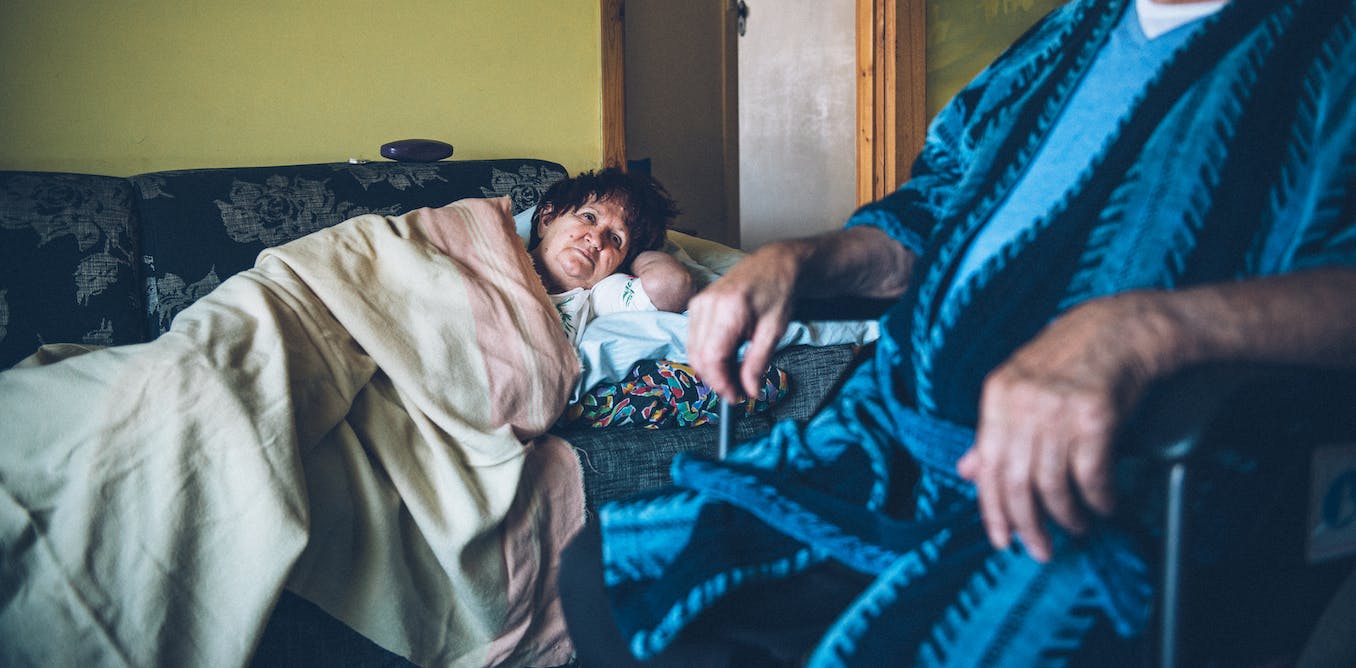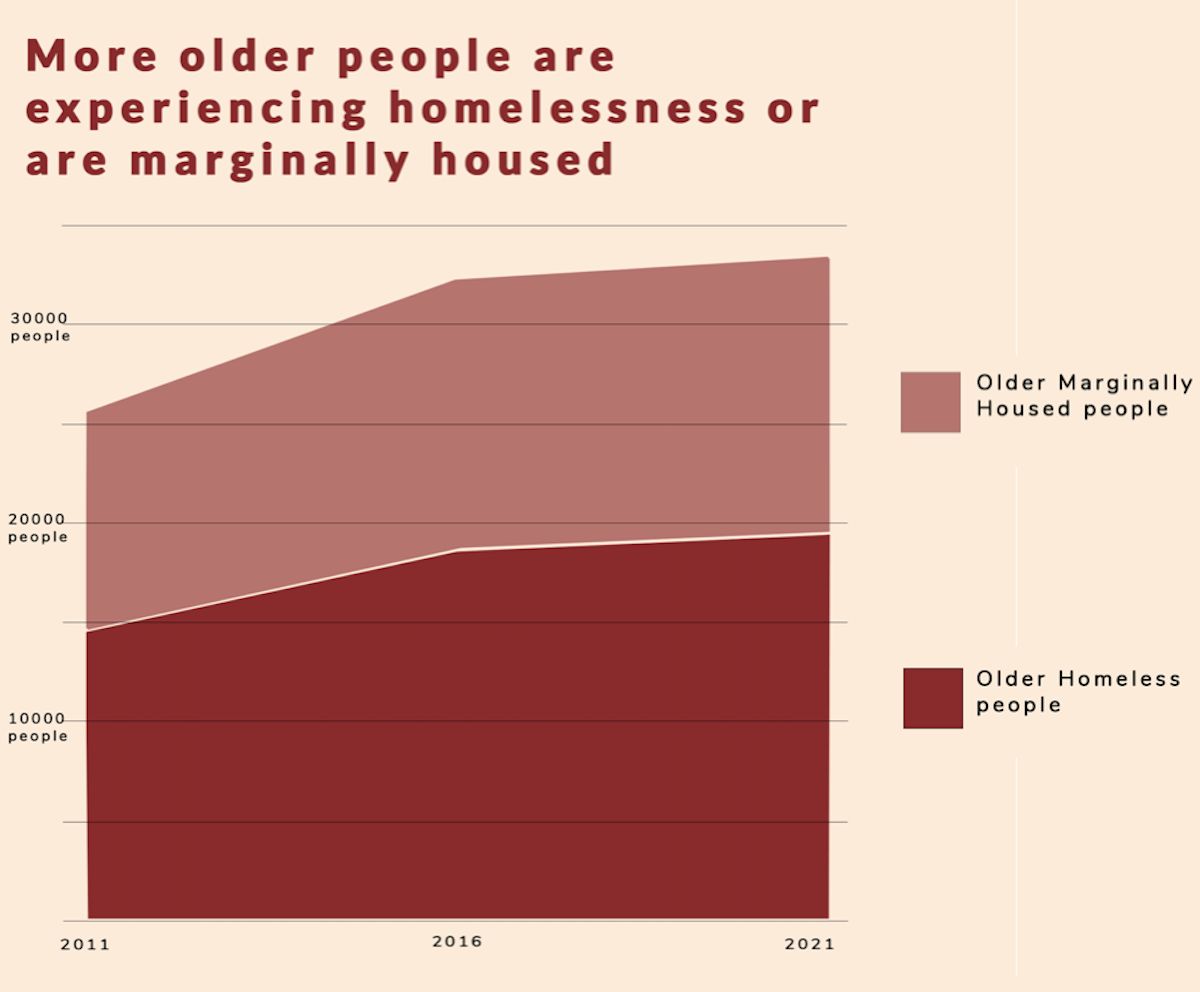Ageing in a housing crisis: growing numbers of older Australians are facing a bleak future

Image courtesy of the Housing for the Aged Action Group
In summary
Analysis for The Conversation by Centre of Urban Transitions Researchers Professor Wendy Stone, Dr Piret Veeroja & Margaret Reynolds
The collision between an ageing population and a housing crisis has left more older people in Australia enduring housing insecurity and homelessness. Our research, released today, explores how the scale of these problems among older people has grown over the past decade.
Our report, Ageing in a Housing Crisis, shows safe, secure and affordable housing is increasingly beyond the reach of older people. This growing housing insecurity is system-wide. It’s affecting hundreds of thousands of people across all tenures, including home owners and renters.
The federal government released Australia’s first national wellbeing framework, Measuring What Matters last month. It recognises “financial security and access to housing” as essential for a secure, inclusive and fair society. However, urgent policy action is needed to reshape the Australian housing system so all older people have secure, affordable housing.

Older people are increasingly at risk
We analysed the most recent Australian Bureau of Statistics (ABS) census data and homelessness estimates. More older people lived in marginal housing – defined by the ABS as including crowding (less severe), improvised dwellings and caravans – and more were homeless in 2021 than a decade earlier.
Older people experiencing homelessness by gender and category in 2011, 2016 and 2021.

The proportion of older people in private rental housing has also increased. This means more older people are exposed to the insecurity of renting and rising rents. Our work shows they are struggling to afford private rental housing.
The lowest-income households are the hardest hit. The private rental market is failing to supply housing they can afford. The shortfall in subsidised social housing is huge.
Older people who receive government benefits and allowances are at most risk because their incomes are not keeping up with housing costs.

Image: Authors & Housing for the Aged Action Group
In 2019-20 only 19% of older people on very low incomes (the lowest 20% of household incomes) lived in households whose rent was affordable. This means four out of five were spending more than 30% of their income on rent (the affordability benchmark for low-income households). Two in five were paying severely unaffordable rents – more than 50% of their income.

Image: Authors & Housing for the Aged Action Group
For older people who don’t own their homes, rising housing prices create financial risk rather than windfall. At the same time, more older people have mortgages. This increases their risk of housing insecurity or financial stress in retirement.
Ageing magnifies unaffordable housing impacts
Rising housing costs, falling home ownership rates, mortgage debt carried into retirement, insecure private rental tenures and the worsening shortage of social housing are markers of system-wide housing insecurity.
Insecure or marginal housing affects all generations. However, for older people the risks are made worse by limited income-earning ability, increasing frailty, illness and/or caring responsibilities, growing need for at-home support, and age-based discrimination. These factors make it even harder to meet rising housing costs.
Housing insecurity widens the gap between the housing older people have and the housing they need to live safe, secure and dignified lives as they age.

Image: Authors & Housing for the Aged Action Group
System-wide risks demand system-wide action
Growing housing insecurity among older people is a result of system-wide problems. This means system-wide solutions are needed.
We call for:
Adequate social housing supply that reflects population growth and ensures it’s available for older people across all states and territories, including by increasing aged-specific options and reducing the age at which social housing applicants are given priority to 45-55.
Stronger national tenancy regulations that prioritise homes over profit.
Dedicated marginal and specialist homelessness services that are well designed with and for older people who have experienced housing insecurity and support systems.
Support for people to remain in their own homes, across all tenures.
Responses and assistance models must allow for gender diversity, income difference, Aboriginal and/or Torres Strait Islander people’s cultural needs, as well as those of other culturally and linguistically diverse older people. Disability, caring responsibilities, history of trauma, and individuals’ unique housing pathways and experiences must all be considered.
Older people must have a say in reshaping the housing system. The Albanese government is developing a National Housing and Homelessness Plan. It’s essential that this plan, along with state, territory and local government implementation plans, consider the voices, experiences, concerns and aspirations of older people.
Housing reform is good for everyone
Older people are only one part of the population facing housing insecurity and homelessness. A comprehensive national housing plan must respond to all generational needs. Housing solutions for older people must not come at the expense of – or compete with – the needs of other generations.
Housing insecurity and homelessness in childhood, younger years and early adult life all warrant meaningful and urgent housing solutions. Making sure all people have lifelong access to secure housing will begin to reverse the growing problems identified by our report. Otherwise, Australia faces a future where more and more older people struggle with inadequate and unaffordable housing.
National reform that includes a focus on generational needs can deliver a housing system that provides affordable homes for everyone. This will ensure everyone is able to maintain community connections, which for older people means being able to age in safe, secure and affordable homes.
This article was originally published on The Conversation.
-
Media Enquiries
Related articles
-

- Social Affairs
Landmark Swinburne study exposes ongoing discrimination and homophobia
More than half of LGBTIQA+ young people in Australia have witnessed discrimination in community-based sport, according to a new Swinburne University of Technology study.
Friday 17 May 2024 -

- Social Affairs
Too many renters swelter through summer. Efficient cooling should be the law for rental homes
Summer is coming – and it’s starting earlier, becoming hotter and lasting longer. As the hot weather hits, many renters will be sweltering in their homes. The World Health Organization recommends a list of actions for people to deal with heat. At the top of the list is “keep your home cool”. But for many renters, this isn’t possible.
Wednesday 22 November 2023 -

- University
- Social Affairs
In 5 years, this Australian astrophysics lab reached 50% women. Here’s how they did it
Many organisations, from community sporting groups to the United Nations, have set themselves a target of gender parity: ensuring half of staff or members are women. Gender parity is desirable because training and retaining equal halves of a population’s available talent influences an organisation’s growth, problem-solving capacity and future-readiness.
Friday 17 November 2023 -

- Social Affairs
Swinburne students win third consecutive Advertising Capstone Challenge
Four Swinburne students have designed a winning campaign for BONDS Bloody Comfy Period Undies.
Friday 10 November 2023 -

- Social Affairs
- Design
Swinburne helps Pasifika youths develop life skills and thrive
Up to 100 Pasifika youths have graduated from Swinburne’s Discovery Sprint program, where young people can gain skills that could kickstart careers in in-demand industries.
Monday 02 October 2023

